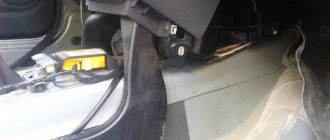Affordable family car
A front-wheel drive station wagon with a 1.6-liter 8-valve engine began to be produced at the VAZ automobile plant. Lada Largus (from Latin - “generous”) is a repetition of the Dacia Logan MCV station wagon made in Romania, manufactured on the B0 platform, which is used in the manufacture of vehicles for various purposes with an elongated wheelbase. Both variants of the Lada Largus car are being considered: with 5 and 7 seats (in the seven-seater, the seats are arranged in 3 rows).
The Largus luxury package includes airbags, power steering, a car radio, and mountings for child seats. The car is of impressive size, weighing approximately 1200 kg. The model is presented in a regular, rustic design, with good side visibility, and has a galvanized body, which is characterized by high windage.
The salon is equipped with three rows of seats; the interior decoration does not look rich in appearance. The operation of the car's instruments and steering is presented at a fairly good level. It is comfortable to be in the first two rows of seats, the last row is narrower in terms of capacity. In a five-seater Lada Largus, the trunk volume is 700 liters.
Main characteristics of the car
By folding the second row seats, you can increase the interior space to 2350 liters. The model in question has been on sale since 2012 and has been of great interest to many car enthusiasts both for its advantages and disadvantages.
Advantages
- Indestructible Logan suspension.
- Roomy interior, huge trunk.
- Moderate cost of maintenance and repair.
You won’t find anything new or unfamiliar here – but that’s exactly what many drivers like.
You won’t find anything new or unfamiliar here – but that’s exactly what many drivers like.
Knocks in the engine
Every car enthusiast knows that knocks and noises in the engine indicate his imminent death. Therefore, you need to be attentive to extraneous sounds and correctly determine their localization.
Causes of knocking in the engine:
- Loose pistons;
- Worn crankshaft main bearings;
- Worn connecting rod bearings.
Repair
If you are sure that the pistons or bearings are knocking, then you need to overhaul the engine. This is a complex procedure and is best done under the guidance of a mentor. You can also watch the video of repairing the Lada Largus with your own hands to learn all the nuances.
Operational problems
- It makes sense to listen to the suspension after 70,000 km. Ball joints may fail a little earlier if you drive frequently on bad roads.
- CV joint boots are unpredictable, as are expansion tanks on cars with Granta engines.
- The brake system consumables are not very durable: pads last 30,000 km, discs - about 50,000 km.
- Failures of the first speed windshield wipers are frequent; Electricians are generally not the strongest link in the Logan family.
Euro NCAP:
The test was carried out only for the Logan sedan (2005) - driver/passenger, child, pedestrian.
The most popular aftermarket offer: Largus 1.6 with K4M engine
OPTIMAL CHOICE:
Largus 1.6 with K4M engine
FOR THE SAME MONEY:
Ford Focus II, Kia Сee'd, Opel Astra H, Chevrolet Cruze
- Do you want to take more things on the road and free up the interior for passengers? Come get your car roof rack and box!
Problems with the chassis
The wheel bearing hummed - at first it was barely noticeable, then the noise intensified, but there was no play when the suspended wheels rocked. It felt like the left wheel bearing was humming, but the sounds spread through the car in the most incomprehensible way. We hung up both front wheels, started the engine, put the car in gear and listened to the noise from under the car with a stethoscope. We tried to determine the source of the hum using a long screwdriver placed against the steering knuckle and the ear. All these methods did not allow us to draw an unambiguous conclusion about which bearing was faulty. As a result, the diagnosis was made based on the results of the simplest road test: when turning right, the hum became stronger, which means the left bearing, which is more loaded, is to blame. The disassembly confirmed the fears.
The surface of the bearing outer ring has become chipped, known as pitting. The bearing has been replaced. The hum stopped. |
New bearing from Optimal with nut, retaining ring and ABS sensor holder. The ABS sensor mount is unreliable and inconvenient. The bearing cost 2300 rubles. |
Since everything had to be disassembled, the brake discs were also replaced. Their thickness was only 17 mm. Keep in mind that during heavy braking, discs with such wear can easily overheat. New brake discs cost 3,300 rubles.
The brake discs have done 130,000 km and have no runout or any other problems other than being too thin. Excellent result.
The brake discs have done 130,000 km and have no runout or any other problems other than being too thin. Excellent result.
Manual transmission breakdowns
The manual transmission is considered the most reliable among all types. In domestic cars, manual transmission does not cause problems up to 200-250 thousand km with regular oil changes. But at high mileage, Largus owners complain about malfunctions.
Signs of damage:
- Crunching noises when changing gears;
- Inability to engage gear;
- Sharp mechanical sounds during movement;
- Spontaneous jumping out of gear.
Manual transmission repair
Most often, manual transmission malfunctions are associated with a broken gear selection cable. You can repair a Lada Largus car with your own hands in the garage by disassembling the box. But if you do not have experience, it is better to turn to craftsmen who can disassemble, repair and reassemble.
Reviews
Alexander Tatishchev, Yaroslavl, Comparison of Kalina and Largus with a 16-valve engine
I was lucky to be the owner of 2 cars of our production: Kalina 2 with an 8-valve engine and Largus with a new 16-valve engine. Well, like new - borrowed. Therefore, for fun, I decided to compare the 16 valve engine and the Largus with the VAZ engine and write a review about my feelings.
For your information! Kalina is also equipped with a VAZ 11189 engine with 8 valves.
I often drive Kalina fully loaded, since my professional occupation is construction. It happens that she has to carry half a ton. Well, Kalina on the 11189 engine with 8 valves is quite playful. Even when climbing, it is easy to overtake. Our engineers built an excellent 8 valve engine, in my opinion.
Largus will have a greater carrying capacity, but the weight of the car will also be greater. I even did a little tuning, but it doesn't help. The car does not drive stupidly, there is no agility even when empty. Therefore, the K4M engine in the Lada Largus with 16 valves does not deserve the most flattering reviews.
I'm seriously thinking about changing Largus to another car. You can even use Kalina, only newer.
Ivan Kulba, Lada Kalina 2 with VAZ 11189 engine, Nizhny Novgorod
For the last 2 years I have been driving Kalina 2. I live in a rural area, so I carry a lot of cargo, both domestic and for work. In general, the car is always loaded. I did not experience any problems during operation. From time to time it was necessary to adjust the valves at a company service center. Well, standard maintenance. I have driven 20 thousand in 2 years. I know that even if 11189 with 8 valves breaks down, its repair will not be expensive. I use semi-synthetic oil. My neighbor has a Lada Largus with a VAZ 11189 engine and his reviews are not so flattering. Once he let me drive in his empty car. Largus has no dynamics at all. I don’t even know how people tolerate such a dull throttle response. Perhaps the reworking of the engine to the Euro 5 standard had an effect, but the car should not lose so much in dynamics. It’s good that the amount of repairs, if anything, will be the same. But what about the 16 valve Largus? Repairs there will cost a pretty penny.
This is interesting: Why doesn't the cigarette lighter in the car work? DIY repair in 5 steps
For your information! Simplicity of design is the main distinguishing feature of the VAZ 11189 engine, compared to a foreign-made 16-valve engine. If the latter breaks down, repairs will be significantly more expensive. True, the French engine is more modern than ours.
Nikolay the Last, Lada Largus 1.6 (105 hp) 2014, Ulyanovsk
In principle, the car is not bad, quite roomy. But there is one unpleasant feature. It’s as if the designers were in cahoots with the oil workers, or the engineers don’t know how to do calculations! The fact is that fuel consumption is 6 liters. 100 km outside the city can only be achieved at a speed of 60 km/h. But will there be anyone willing to plod along at such a snail’s pace? We have damaged roads, but not to the same extent. This car should have such consumption only at 90 km/h. Although the manufacturer claims that the 16-valve engine is economical, this does not turn out to be the case in practice. I don’t know what kind of engine chip tuning the Lada Largus needs to get a positive review. And the dynamics – it’s as if they don’t exist. When the air conditioning is turned on in the summer, the already slow car still loses its dynamics. As for the standard speed of 90 km/h, the engine has 8.5 liters per hundred. No good!
For your information! The air conditioning compressor is driven through a clutch from the engine and can eat up part of its power, which leads to increased fuel consumption.
Alexander Kisly, Lada Largus for 5 seats, 8-valve engine, Astrakhan
A new car is a good purchase. Anything better than an old foreign car. But after it, in my native Lada there are not enough useful little things in the cabin. You adapt to this. In principle, Largus is a good compromise between cost and quality.
As for the review of the Lada Largus VAZ 11189 engine, I am frightened by the high fuel consumption. The data differs somewhat from what the manufacturer claims. At a speed of 130 km/h on the highway, it produces as much as 10 liters per hundred. This is a bit much. But I didn’t load the car to capacity. What happens when it's fully loaded? Regarding the engine, it is worth noting that the 8-valve version is rather weak for Largus. This requires a more powerful motor. But according to rumors, even a 16-valve engine is not enough for dynamic driving.
About the 5th stage. They say that the engine roars on it, but there is no speed. At 3 thousand my tachometer shows a speed of 100 km/h. At 4 thousand - 120 km/h.
For your information! The manufacturer states that on the highway the VAZ 11189 engine with 8 valves should have a consumption of just under 7 liters. In the city 9-10 l. Well, the data is a little different from reality.
Nikita Khrapsky, Lada Largus 2013, engine – 16-valve, Arkhangelsk
I was afraid when buying a car. Still, Lada cars have a bad reputation. But the machine has been serving faithfully in construction projects for 2.5 years. Helps transport cargo, even light ones. I don’t put a lot of load on it, but I don’t pamper the car either.
The 16 valve K4M engine on my Lada Largus deserves a good review, since there were no breakdowns during operation. I haven’t driven it that much – only 43 thousand km. Having read stories about the timing belt, I’m already getting ready to change it. Still, you don’t want to end up with expensive valve repairs because they break. Well, everything is according to my manual. I even always go through the service a little earlier, so that the car does not reach the 2-3 thousand service date. So I warn her against breakdowns. Still, I travel a lot.
This is interesting: Chevrolet Cruze crash test
As for the dynamics, I'm used to it. Although after the foreign car the first time was not easy. But what can you do - this is how the engineers created this car. All that remains is to use it. It's worth the money.
Ivan Sytko, Lada Largus 2014, 16-valve engine, Novosibirsk
I have had the car for 2 years. Complaints? Domestic. There are shortcomings in many areas, but they are minor, and somehow I’ve already gotten used to it. It’s a sin to criticize a manufacturer who offers a new car for that kind of money, and even his own.
As for the dynamics of the 16 valve engine, Largus has plenty of it in city traffic. In principle, it’s comfortable to drive on the highway, but up to 115 km/h. If you want to go higher, you need to change the 5th gear ratio. 92 gasoline works great for Largus, although the manual says to use 95. But the latter contains a lot of additives - I don’t want to spoil the fuel system and would rather take care of the injectors. Once I filled up with 95 in some remote place, I don’t want to remember it. I don't know how the engine held up. Probably, another person would have already broken down from such vibrations. In general, I cleaned the entire fuel system.
As for the pros:
- high maintainability;
- there are a lot of spare parts and they are cheap;
- reliable engine.
Flaws:
- fuel consumption is higher than the manufacturer claims;
- You can hear engine noise at medium and high speeds.
In general, the consumption hits your wallet a little, you get used to the ergonomics, but otherwise there are no complaints.
Mikhail Prokopyev, Largus 2012 with 16-valve engine, Tambov
I was among the first Largus buyers in the city. I chose the 16 valve version because I needed a powerful and reliable engine. I travel a lot. I work in forestry, so I have to travel long distances.
It’s not a shame to damage a domestic car – it can always be repaired. This quality was adopted by Largus. The engine is good, but lacks traction on the highway. And in the city it’s rather weak. But I rarely go there, so maybe its stiflingness only seems to me. I read the reviews - it doesn’t seem like it.
I changed the timing belt at 60 thousand. But the noise was already heard at 20 thousand. I don’t know how I didn’t get the valves repaired. I was lucky because I read about him later.
Wear of ball joints
This is a weak point on all seven-seater cars, as the load is much higher than on the five-seater versions. When buying a used car, ask in what conditions it was used and how often the Lada Largus was repaired. To assess the condition of the ball joints, contact a car service center or check them yourself on an overpass.
Signs of wear:
- knocking in the suspension when passing a speed bump;
- play when the wheels swing on an overpass;
- instability of the front wheels.
Repair
If you encounter such a problem, you need to immediately repair Largus in order to extend the life of the entire suspension. It is performed on a special machine for restoring ball joints, so you need to contact a car service center. Carrying out such repairs on your own is problematic.
Summing up
The presented reviews about the main Largus engines - the 8-valve VAZ 11189 and the foreign 16-valve engine - indicate that for full-fledged dynamics the car needs a slightly more powerful engine. Perhaps the engineers intended a calm and obedient car, but in reality it turned out to be very sluggish.
The weakness of the engines, even the 16-valve version, is evidenced by the fact that they consume fuel a little more than stated. Almost everyone complains about this. For comparison, you can take Kalina 2 from the first review with the same 8-valve engine. According to the user, he walks confidently and dynamically, which Largus lacks.
You can apply tuning to both engines, but this is an additional cost. In addition, the warranty on a new car will be void. It’s easier to buy another car and not have to worry about it. Although some people like to tinker with hardware. The 8-valve engine can be throttled from environmental control, and the 16-valve engine, in general, has wide chip tuning capabilities that allow you to increase the power to 150 hp. With.
a van for life and soul. Inside Lada Largus
Department of Childhood Diseases: Lada Largus
Judging by the reviews, in the case of the Lada Largus, everyone distinguished themselves a little: either the domestic assembly will let us down, then the French “heart” will begin to play pranks over little things, or the overly complex logistics and component delivery system will play a cruel joke. However, Largus is no longer a newcomer to the market, and all serious problems have already been solved through the joint efforts of AvtoVAZ and the Renault-Nissan alliance. Official dealers, as well as specialists from “garage” services who had the opportunity to communicate with this model, told us about the weak points of the Lada Largus.
Air conditioner leak
“From the first day of operation, air conditioning condensate has been flowing under the front passenger’s feet. I read about the problem on the Largus forums - everyone has a leak. If you didn’t know about this, put your hand under the rug - there’s already a bucket’s worth of water splashing there,” writes the owner of Largus, Sergei, in his review on the website wroom.ru. Perhaps not everyone has encountered a lake at the feet of the front passenger, but certainly many have: there are enough cars that are “raw” in every sense for the manufacturer to pay close attention to the problem. It turned out that this is a “childhood disease” not so much of the machine as of the assembly. The drain hole in the heater housing simply did not line up with the drain valve hole installed in the car body.
To begin with, AvtoVAZ sorted out the problem on already produced cars: the case was recognized as under warranty, and official dealers received an information letter from the manufacturer, according to which the leak was fixed free of charge for the owners. The repair process was fairly simple: the heater top mounting screws and dash amp mounting bolts were loosened, the heater bottom was aligned so the drain holes lined up, and everything was put back together. The main thing is that the “tongue” of the amplifier gets into the U-shaped boss of the heater housing - this is a sure sign that everything is assembled correctly. The problem was also solved in production: according to the manufacturer, control over the installation of the instrument panel was strengthened on the assembly line.
CV boots are torn
The boots of CV joints, which could not stand the test of Russian cold and roads, became, perhaps, the most discussed topic in the circles of “largus drivers”. Rubber “accordions” tore literally within the first thousand kilometers, exposing the delicate insides of the drives to road dirt. The result, of course, was not long in coming: strong crunching noises when turning the steering wheel more than once bothered the owners who did not have time to notice the rupture of the boot in time and contact the officials.
However, contacting dealers also did not always promise an easy solution to the problem: according to technology, the entire drive assembly had to be replaced, and not just the boot (and there were cases when dealers did not immediately agree to resolve the warranty issue). Very quickly these drives became in short supply, and owners had to wait a long time for them. In this regard, the fact that the parts were supplied from Romania and, as representatives of AvtoVAZ explained, a lot of time was spent on customs clearance did not help in this regard.
“...November 2012, mileage 9800, the left boot cracked on the clamp, a grenade crunched, 04/22 contacted the dealer, they determined it was under warranty, the day before yesterday I called them, they answered that there were no drives even at the factory. I didn’t expect such an ambush from Largus, I need a car every day...” wrote user Dmitry Radygin in a thematic group on the VKontakte social network.
The reason for the fragility of the anthers was complex. They suspected, in particular, a design miscalculation: supposedly the boot was too small for the CV joint on which it was installed, because of this it was tightened and easily torn. This happened especially often in winter, when the anther material became dull. “We need to introduce a new position at AvtoVAZ - anther crusher, or stop selling Largus cars in the winter... It’s some kind of nonsense, honestly,” writes Admin on the lada-largus.com forum.
It is worth recognizing that the manufacturer actively supported feedback, collected statistics on this malfunction, and the solution to the problem, they say, was taken under control by the president of AvtoVAZ himself. AvtoVAZ fought with the torn anthers jointly with the Renault Nissan alliance, and approached the problem comprehensively: they updated the design of the anthers, the assembly technology in production, and even transportation methods.
The dealers were unable to provide details of the changes - some of the improvements were carried out by the alliance - however, they stated that since the end of 2013, a new type of anthers began to be installed on cars, for which much fewer problems and questions arise. This, by the way, was confirmed by one of the garage services.
The back of the chair doesn't hold up
On many Largus, the back of the driver’s seat stubbornly refuses to stay in place and gradually, slowly, begins to lean back. “The designers apparently specially provided for this so that there would be no congestion in the back, and depression in the spine...” jokes Dima56rus on the website lada-largus.com.
The reason for the excessively movable backrest of the chair turned out to be an adjustment spring, which the owners quickly got used to tightening themselves with a clamp, thus fixing the backrest in one position. Then the manufacturer arrived: in the summer of 2015, a bulletin was issued, according to which owners were required to repair the adjustment mechanism as part of the warranty. The officials already did without clamps and replaced the defective spring with a higher-quality analogue.
The root of the problem lies in the batch of seat sets that . By the way, another defect was recorded with chairs from this supplier - the unreliability of the heating elements. There were fewer cases of the driver's seat heating not working, officials say, but this problem was also included in the technical bulletin and subsequently corrected during production.
Engine speed fluctuates
“I’m completely tired of the car’s capriciousness. It would be nice if the revolutions fluctuated for 5-10 minutes when warming up, but even after that, while driving, small jumps in revolutions occur on an unheated engine (and sometimes significant ones - the car itself raises the revolutions to 3-3.3k),” writes Ilya Mashintsev on the website drive2.ru.
Floating speed on 16-valve Renault engines is a fairly well-known feature, and Largus was not spared from it either. The problem was the rubber o-ring on the throttle valve - it was sagging, and air began to leak through it.
The manufacturer recognized the problem as a warranty case, and official dealers changed (and are changing) the rings without any problems when contacted. It is worth noting that at first, officials often replaced the entire throttle assembly under warranty, although the problem was completely eliminated by replacing the rubber rings.
However, it won’t be difficult to fix the problem yourself. Many owners complained that the rings replaced under warranty did not last long, and simply coated the rings with silicone or wrapped them with fum tape, making them thicker. The solution turned out to be effective and quite reliable. By the way, they say that some dealers sometimes even offer to wrap the rings with fum tape instead of replacing them. There is a more elegant solution for those who do not want to “collectively farm” fum tape: it is not difficult to select a denser and softer o-ring of the required diameter.
***
Of course, the owners of classmates and competitors can gloat and be in full confidence that they definitely made the right choice and bought the most reliable and problem-free car. But ideal cars do not exist, and the fact that your favorite model has not yet appeared in this section (or have you not yet gone through the list of all the materials in the section?) means only one thing: we just haven’t gotten to it yet.
auto.vesti.ru
What problems does Lada Largus have?
The first problems of the Lada Largus station wagon were identified already in the first week of the start of car sales. Assembly defects can be either not very serious or quite significant, which simply will not allow the car to drive. The manufacturer recognizes some of the malfunctions as their faults and eliminates them under warranty, however, sometimes you have to wait a very long time for this.
One of the first unpleasant surprises that the Lada Largus can present to its owners after only 200 km is the wire of the starter solenoid relay that is shorted on the engine due to frayed insulation. This deficiency manifests itself in the fact that the car refuses to start, and the instrument panel does not react in any way to turning the key in the ignition switch.
There may also be problems with the chassis with CV joint boots or, as they like to be called colloquially, “grenades”. In cold weather, hard rubber boots
xn--44-6kchdmw3bgiawoo4b.xn--p1ai











